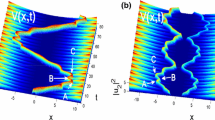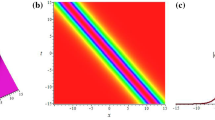Abstract
In this paper, a class of variable coefficient coupled Schrödinger equations with gain or loss terms is studied, which can be used to describe soliton excitation in non-uniform trihydrogen chain \(\alpha \)-helix proteins. The N-soliton solutions of this equation are obtained by using the Hirota bilinear method, the 1,2, 3-soliton solutions are numerically simulated, and their dynamic properties are analyzed. On this basis, the asymptotic behavior of soliton solutions is discussed. Besides, the influence of variable coefficient function and other parameters on solitons is studied, the corresponding rules are summarized.
















Similar content being viewed by others
Data Availability
Data available within the article or its supplementary materials. We confirm that the data supporting the findings of this study are available within the article and its supplementary materials.
References
Rabinowitz, P.H.: On a class of nonlinear Schrödinger equations. Z. Angew. Math. Phys. 43(2), 270–291 (1992). https://doi.org/10.1007/BF00946631
Taha, T.R., Ablowitz, M.I.: Analytical and numerical aspects of certain nonlinear evolution equations. II. Numerical, nonlinear Schrödinger equation. J. Comput. Phys. 55(2), 203–230 (1984). https://doi.org/10.1016/0021-9991(84)90003-2
Shi, Y., Zhang, Y., Xu, S.: Families of nonsingular soliton solutions of a nonlocal Schrödinger–Boussinesq equation. Nonlinear Dyn. 94, 2327–2334 (2018). https://doi.org/10.1007/s11071-018-4491-8
Nisar, K.S., Ali, K.K., Inc, M., et al.: New solutions for the generalized resonant nonlinear Schrödinger equation. Results Phys. 33, 105153 (2022). https://doi.org/10.1016/j.rinp.2021.105153
Helal, M.A.: Soliton solution of some nonlinear partial differential equations and its applications in fluid mechanics. Chaos Soliton Fract. 13(9), 1917–1929 (2002). https://doi.org/10.1016/S0960-0779(01)00189-8
Shi, Y., Shen, S.F., Zhao, S.L.: Solutions and connections of nonlocal derivative nonlinear Schrödinger equations. Nonlinear Dyn. 95, 1257–1267 (2019). https://doi.org/10.1007/s11071-018-4627-x
Ren, P., Rao, J.: Bright-dark solitons in the space-shifted nonlocal coupled nonlinear Schrödinger equation. Nonlinear Dyn. 108(3), 2461–2470 (2022). https://doi.org/10.1007/s11071-022-07269-x
Ma, W.X.: N-soliton solution and the Hirota condition of a (2+1)-dimensional combined equation. Math. Comput. Simul. 190, 270–279 (2021). https://doi.org/10.1016/j.matcom.2021.05.020
Rizvi, S.T.R., Seadawy, A.R., Farah, N., et al.: Application of Hirota operators for controlling soliton interactions for Bose–Einstien condensate and quintic derivative nonlinear Schrödinger equation. Chaos Soliton Fract. 159, 112128 (2022). https://doi.org/10.1016/j.chaos.2022.112128
Davydov, A.S., Kislukha, N.I.: Solitary excitons in one-dimensional molecular chains. Phys. Status Sol. (B) 59(2), 465–470 (1973). https://doi.org/10.1002/PSSB.2220590212
Shen, Y., Tian, B., Cheng, C.D., et al.: Bilinear auto-Bäcklund transformation, breather-wave and periodic-wave solutions for a \((3+1)\)-dimensional Boiti–Leon–Manna–Pempinelli equation. Eur. Phys. J. Plus 136, 1–13 (2021). https://doi.org/10.1140/epjp/s13360-021-01987-8
Raza, N., Ur Rahman, R., Seadawy, A., et al.: Computational and bright soliton solutions and sensitivity behavior of Camassa–Holm and nonlinear Schrödinger dynamical equation. Int. J. Mod. Phys. B 35(11), 2150157 (2021). https://doi.org/10.1142/S0217979221501575
Mahmud, F., Samsuzzoha, M., Akbar, M.A.: The generalized Kudryashov method to obtain exact traveling wave solutions of the PHI-four equation and the Fisher equation. Results Phys. 7, 4296–4302 (2017). https://doi.org/10.1016/j.rinp.2017.10.049
Mohyud-Din, S.T., Irshad, A.: Solitary wave solutions of some nonlinear PDEs arising in electronics. Opt. Quantum Electron. 49, 1–12 (2017). https://doi.org/10.1007/s11082-017-0974-y
Abdul Kayum, M., Ali Akbar, M., Osman, M.S.: Stable soliton solutions to the shallow water waves and ion-acoustic waves in a plasma. Wave Rand. Complex 32(4), 1672–1693 (2022). https://doi.org/10.1080/17455030.2020.1831711
Wang, L., Luan, Z., Zhou, Q., et al.: Bright soliton solutions of the \((2+1)\)-dimensional generalized coupled nonlinear Schrödinger equation with the four-wave mixing term. Nonlinear Dyn. 104, 2613–2620 (2021). https://doi.org/10.1007/s11071-021-06411-5
Chen, J., Luan, Z., Zhou, Q., et al.: Periodic soliton interactions for higher-order nonlinear Schrödinger equation in optical fibers. Nonlinear Dyn. 100, 2817–2821 (2020). https://doi.org/10.1007/s11071-020-05649-9
Mo, Y., Ling, L., Zeng, D.: Data-driven vector soliton solutions of coupled nonlinear Schrödinger equation using a deep learning algorithm. Phys. Lett. A 421, 127739 (2022). https://doi.org/10.1016/j.physleta.2021.127739
Wang, D.S., Yin, S., Tian, Y., et al.: Integrability and bright soliton solutions to the coupled nonlinear Schrödinger equation with higher-order effects. Appl. Math. Comput. 229, 296–309 (2014). https://doi.org/10.1016/j.amc.2013.12.057
Peng, W.Q., Tian, S.F., Wang, X.B., et al.: Riemann-Hilbert method and multi-soliton solutions for three-component coupled nonlinear Schrödinger equations. J. Geom. Phys. 146, 103508 (2019). https://doi.org/10.1016/j.geomphys.2019.103508
Qin, B., Tian, B., Liu, W. J., et al. Solitonic excitations and interactions in the three-spine \(\alpha \)-helical protein with inhomogeneity. SIAM J. Appl. Math. 71(4), 1317-1353 (2011). https://www.jstor.org/stable/23070186
Wang, X., Zhang, L.L.: The vector soliton of the \((3+1)\)-dimensional Gross–Pitaevskii equation with variable coefficients. Nonlinear Dyn. 111(6), 5693–5708 (2022). https://doi.org/10.1007/s11071-022-08121-y
Liu, J., Jin, D.Q., Zhang, X., et al.: Excitation and interaction between solitons of the three-spine \(\alpha \)-helical proteins under non-uniform conditions. Optik 158, 97–104 (2018). https://doi.org/10.1016/j.ijleo.2017.11.200
Zhang, S., Cai, B.: Multi-soliton solutions of a variable-coefficient KdV hierarchy. Nonlinear Dyn. 78(3), 1593–1600 (2014). https://doi.org/10.1007/s11071-014-1539-2
Liu, S., Zhang, X., Xu, L., et al.: Expectation-maximization algorithm for bilinear systems by using the Rauch–Tung–Striebel smoother. Automatica 142, 110365 (2022). https://doi.org/10.1016/j.automatica.2022.110365
Fei, Q., Ma, J., Xiong, W., et al.: Variational Bayesian identification for bilinear state space models with Markov-switching time delays. Int J Robust Nonlinear 30(17), 7478–7495 (2020). https://doi.org/10.1002/rnc.5190
Wang, J., Wu, H.: Rational solutions with zero background and algebraic solitons of three derivative nonlinear Schrödinger equations: bilinear approach. Nonlinear Dyn. 109(4), 3101–3111 (2022). https://doi.org/10.1007/s11071-022-07593-2
Acknowledgements
Research Project Supported by Shanxi Scholarship Council of China (2021-030).
Funding
This paper is supported by Shanxi Youth Scientific Research Project. The Project Number is 202103021223060.
Author information
Authors and Affiliations
Corresponding author
Ethics declarations
Conflict of interest
The authors have no relevant financial or non-financial interests to disclose.
Additional information
Publisher's Note
Springer Nature remains neutral with regard to jurisdictional claims in published maps and institutional affiliations.
Rights and permissions
Springer Nature or its licensor (e.g. a society or other partner) holds exclusive rights to this article under a publishing agreement with the author(s) or other rightsholder(s); author self-archiving of the accepted manuscript version of this article is solely governed by the terms of such publishing agreement and applicable law.
About this article
Cite this article
Wang, X., Zhang, LL. N-soliton solutions for a variable coefficient trihydrogen chain \(\alpha \)-helix protein system with gain or loss terms. Nonlinear Dyn 111, 21241–21257 (2023). https://doi.org/10.1007/s11071-023-08928-3
Received:
Accepted:
Published:
Issue Date:
DOI: https://doi.org/10.1007/s11071-023-08928-3




